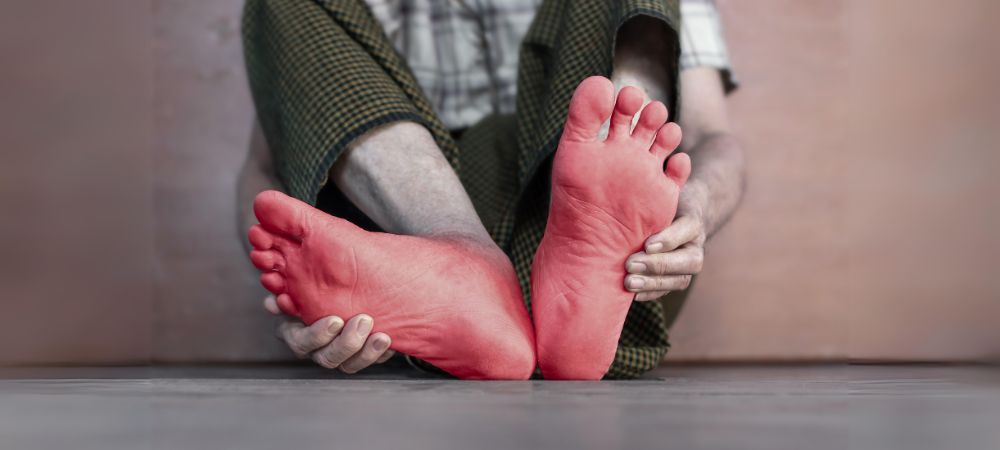Recently updated on December 10th, 2024 at 06:25 am
 Diabetes is a chronic condition characterized by elevated levels of glucose in the blood, which can lead to a variety of health issues, including significant foot complications. Over time, high blood sugar levels can cause nerve damage (neuropathy) that diminishes sensation in the feet, making it difficult for individuals to feel injuries or infections.
Diabetes is a chronic condition characterized by elevated levels of glucose in the blood, which can lead to a variety of health issues, including significant foot complications. Over time, high blood sugar levels can cause nerve damage (neuropathy) that diminishes sensation in the feet, making it difficult for individuals to feel injuries or infections.
Additionally, diabetes can impair blood flow, limiting the body’s ability to heal and increasing the risk of ulcers and infections. These factors make it imperative for those with diabetes to adopt a comprehensive diabetic foot care routine.
This guide provides a detailed, step-by-step approach to safeguarding foot care for diabetics, emphasizing the importance of regular monitoring, proper hygiene, and protective footwear to prevent serious complications and maintain overall well-being. By understanding and managing these risks, individuals with diabetes can take significant steps towards preventing foot-related issues and enhancing their quality of life.
The Importance of Diabetic Foot Care

Diabetes can lead to two major complications that impact foot health: nerve damage (neuropathy) and reduced blood circulation. These conditions create a higher risk for foot injuries and infections, which can escalate into serious health issues if not managed properly. Therefore, implementing a consistent foot care routine is essential for individuals with diabetes to prevent complications such as foot ulcers and severe infections that can lead to amputation in extreme cases. Here’s a more detailed look at how diabetes affects foot health:
- Nerve Damage (Neuropathy): Diabetes often damages peripheral nerves, particularly in the feet, leading to reduced sensation. This loss of feeling means that cuts, sores, or blisters may go unnoticed and untreated, significantly increasing the risk of infection and ulcers.
- Poor Blood Circulation: High blood sugar levels can cause blood vessels to narrow and harden, decreasing blood flow to the feet. Poor circulation weakens the skin, slows the healing process, and reduces the ability to fight infections. In severe cases, poor circulation can lead to critical limb ischemia, necessitating surgical intervention.
Steps for Effective Diabetes Foot Care:
Managing diabetic foot care is critical because the condition compromises blood flow and nerve function, increasing the risk of foot injuries and infections. Here is an expanded guide to each step of effective diabetic foot care:
Step 1: Daily Foot Inspection
Routine daily inspection of your feet is crucial for detecting early signs of potential problems such as cuts, blisters, redness, swelling, or nail issues. Inspecting the feet every day helps identify minor problems before they escalate into serious complications like infections or ulcers.
Use a handheld mirror to examine the soles of your feet, or seek assistance if you have difficulty seeing clearly. This simple, proactive measure can significantly reduce the risk of complications by ensuring that any concerns are addressed promptly.
Step 2: Wash Feet Daily with Care

Hygiene plays a pivotal role in diabetic foot care. It’s essential to wash your feet daily using lukewarm water, which is soothing and less likely to irritate or dry out the skin. Avoid using hot water and harsh soaps that can strip natural oils from the skin, leading to dryness and cracks.
After washing, carefully dry your feet, paying special attention to the areas between the toes. Moisture in these areas can breed fungal infections. Regular, gentle washing and drying are fundamental to maintaining foot health and preventing infections.
Step 3: Moisturize and Protect Your Feet
Moisturizing your feet after washing can prevent the skin from cracking, which is particularly important because breaks in the skin can serve as entry points for infection. Apply a suitable moisturizer to keep the skin supple, focusing on the heels and other areas prone to dryness.
However, it’s crucial to avoid moisturizing between the toes as this can promote fungal growth. Additionally, wearing clean, dry socks made of materials that wick moisture away from the skin can further protect your feet. Diabetic socks typically offer additional padding and non-binding tops and are made from blends that provide optimal moisture management and comfort.
Step 4: Trim Nails Carefully
Proper nail care is essential to prevent complications such as ingrown toenails and infections. Trim your nails straight across to avoid injuring the surrounding skin, and file any sharp edges with a nail file. This will prevent the nails from growing into the skin, which can cause pain and lead to infections.
If your vision is impaired or you have difficulty reaching your toes, it’s advisable to seek assistance from a healthcare provider. Professional care ensures that your nails are trimmed safely, reducing the risk of accidental cuts.
Step 5: Wear Proper Footwear
The importance of wearing appropriate footwear must be balanced. Shoes should be comfortable, supportive, and fit well to avoid areas of excessive pressure that can lead to blisters and sores.
It’s crucial to break new shoes in gradually to ensure they do not rub or pinch. For those with significant deformities or severe neuropathy, custom-made shoes may be necessary to provide adequate support and prevent complications. Shoes designed for diabetic patients often feature extra depth to accommodate orthotics, non-binding uppers, and seamless interiors to minimize irritation.
Step 6: Protect Feet from Extremes

Extremes in temperature can have severe effects on diabetic feet. In hot weather, wearing shoes on the beach or hot pavement is essential to avoid burns, as neuropathy may impair the ability to feel heat.
Similarly, in cold weather, keeping the feet warm is crucial to prevent frostbite, as poor circulation can reduce the ability to keep the feet naturally warm. Protective measures like wearing appropriate footwear and avoiding direct exposure to heat sources or extreme cold are vital.
Step 7: Regular Foot Check-ups
Regular check-ups with a healthcare provider are vital for maintaining foot health in diabetes. These visits allow for a thorough examination of your feet by a professional who can spot early signs of potential problems and provide more comprehensive care as needed.
Regular professional assessments can help manage any ongoing issues, monitor the condition of your feet, and adjust your foot care plan as necessary. These check-ups should be scheduled at least annually or more frequently if you have a history of foot problems. You can also book appointments with in home care services.
Adhering to these detailed steps in your daily routine can drastically reduce the risk of serious foot-related complications. This proactive approach not only helps in maintaining overall foot health but also enhances your quality of life by preventing debilitating conditions that could lead to mobility issues or more severe health consequences.
Supporting Good Foot Health
Maintaining good foot health is essential for individuals with diabetes, as the condition increases the risk of serious complications. Beyond the primary steps of daily care and regular monitoring, several additional strategies can significantly contribute to foot health:
Stay Active
Regular physical activity is crucial for overall health and especially important for managing diabetes and maintaining good foot health.
- Improves Circulation: Exercise helps improve blood flow, which is crucial for diabetic feet, which are prone to poor circulation. Enhanced blood flow aids in faster healing of foot injuries and reduces the risk of infections.
- Reduces Neuropathy Pain: Physical activity can also help reduce the pain associated with neuropathy and prevent its progression by improving nerve function.
- Consult a Specialist: Before starting any exercise regimen, it’s important to consult with a healthcare provider. They can recommend exercises that are safe and beneficial for your specific health condition. Activities like walking, swimming, and cycling are often recommended because they are low-impact but effective at improving blood flow.
Control Your Blood Sugar
Effective management of blood glucose levels is fundamental in preventing the complications associated with diabetes, including those affecting foot health.
- Prevents Nerve Damage: Keeping blood sugar levels within the recommended range can significantly reduce the risk of developing diabetic neuropathy, which can lead to loss of sensation in the feet.
- Aids Healing: Consistently controlled blood sugar also ensures that any wounds or injuries to the feet heal faster and are less likely to develop into serious infections.
- Regular Monitoring: Regular monitoring of blood glucose levels, along with appropriate dietary adjustments and medication adherence, is key to managing diabetes effectively. Get a meal plan for diabetes from a professional.
Avoid Smoking

Smoking has many detrimental health effects, particularly for individuals with diabetes, as it exacerbates circulation problems.
- Impairs Blood Flow: Smoking narrows and hardens the arteries, drastically reducing blood circulation to the extremities, including the feet. This makes it more difficult for injuries to heal and increases the risk of infections.
- Increases Risk of Complications: Smokers with diabetes are at a higher risk of developing severe foot problems, such as ulcers and gangrene, due to the compounded effects of reduced blood flow.
- Seek Help to Quit: Quitting smoking is crucial. Healthcare providers can offer resources, support, and sometimes medication to help quit smoking, significantly improving foot health and overall well-being.
Wear Appropriate Socks
Choosing the right socks is just as important as selecting proper footwear in diabetic foot care.
- Moisture-wicking Fabrics: Look for socks made from materials that draw moisture away from the skin to help keep feet dry, reducing the risk of fungal infections.
- Seamless and Padded: Socks designed specifically for diabetic foot care often have no seams, which can rub and cause blisters or ulcers, and feature extra padding for comfort and protection.
- Proper Fit: Ensure socks fit well; they shouldn’t be too tight (restricting circulation) or too loose (forming bunches that can cause rubbing and pressure points).
Regularly Check Footwear
Frequent assessment of the condition and fit of your shoes is vital for preventing foot complications.
- Monitor Wear and Tear: Regularly inspect shoes for any signs of wear or damage that might cause pressure points or expose the feet to injury.
- Correct Size: Feet can change in size and shape, especially with conditions like diabetes. Ensure your shoes fit correctly every time you purchase new footwear.
Manage Stress

Stress management is an often overlooked aspect of comprehensive diabetic care that can impact foot health.
- Reduces Inflammatory Responses: High-stress levels can lead to inflammation, which may worsen foot problems.
- Promotes Overall Health: Techniques such as mindfulness, yoga, and adequate sleep can reduce stress and promote better overall health, indirectly benefiting foot health.
FAQs:
Conclusion:
Incorporating the seven crucial steps of diabetic foot care into your daily routine is essential for maintaining optimal foot health and preventing serious complications. Regularly practising self-care and seeking professional guidance can markedly enhance your quality of life and manage diabetes-related foot issues effectively.
For elderly individuals requiring additional support, consider hiring Loving Homecare services. They provide specialized foot care that can further safeguard against complications and promote well-being in a comfortable home setting. Reach out to Loving Homecare today to ensure your feet receive the best care possible.

